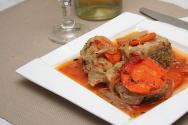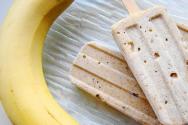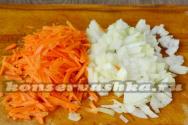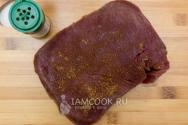Instant mead at home. How to make mead from old honey: a recipe for making it at home. Quick mead with raisins
I became interested in making mead at home. After all, mead at home is a common thing. I decided to look on the Internet to see how people prepare it. Well, you never know who adds anything. I was horrified by the nonsense that had been written and decided to write my own approach, which, in my opinion, is most justified when preparing mead at home.
Preparing mead. Intelligence service.
Okay, maybe this method has a right to life if you cook in the village behind a stove. I read further, and there... And there they recommend adding yeast to the pan, then covering it with gauze and letting it ferment for 2 days...
Guys, I beg you, don’t do this. You can’t imagine how many living creatures will be swimming there in 2 days...
Technology for making mead at home.
Studying a few more resources caused me less indignation, but still...
If we take the technology very briefly, it can be described as follows:
- Preparation
- Cooking the wort
- Seeding
- Fermentation
- Carbonization
Mead at home is prepared in the same way as beer, with the only difference being that the source of sugars is not malt starch, but honey.
Let me remind you that honey is a fermentation product of nectar. The bees have already converted the nectar into the sugars we need, so we don't have to mash anything.
Preparing mead.
Recipes for homemade mead will be at the end. Without knowledge of technology, they will not help.
Preparation
This stage is very important, and I didn’t just take it out separately. A lot depends on preparation and should not be neglected.
What you will need to make homemade mead:
- Pan (larger)
- Bottle
- A stopper with a water seal or at least a medical glove
- Spoon (preferably wooden)
- Hops and other additives (optional)
- Yeast (special, although beer yeast will also work)
- Patience
When you are sure that you have all this, you need to wash the dishes very carefully, paying special attention to the bottle in which the fermentation will take place. If there are bacteria in it, they can ruin your mead. In general, I already wrote about that.
Now a few words about the ingredients.
If you use malt, you will have to mash it, just like when making beer, otherwise there will be no use from it, only dregs.
Honey can be any kind, but cheap purchased honey is most often very diluted. I recommend buying it at the market or from familiar beekeepers. The difference is colossal. It is better to take linden, buckwheat or flower honey.
You can take any water, but it is better from a well or spring. If this is not possible, then bottled. Tap water can spoil the taste.
Select hops according to your taste or according to the recipe. Be careful with other additives.
When everything is ready and washed, we move on to preparing homemade mead.
Cooking wort for mead.
I'm not entirely sure that this can be called wort, but for a general understanding of the concept, we will call it.
So the wort for mead is water and honey.
If you decide to add malt, then first mash the malt, and then add honey to the resulting wort.
If you are preparing simple mead, then honey should be added directly to the water.
Any honey can be used, even if it is already candied.
The resulting wort should be boiled for at least 10-15 minutes. This will destroy all, or almost all, vegetative life forms in the water and honey, if they are there, and they definitely are there.
If you use hops for bittering, then boil the wort with hops for as long as stated in the recipe. You can simply boil the hops in water, and only add honey at the end.
The wort is brewed! Now it should be closed with a lid and cooled to 65 degrees.
Why 65? Well, at this temperature, the wort can be poured into a fermenter, even if it is made of plastic. The second reason is sanitary. At this temperature, bacteria that will get there during overflow will die in the wort. And also, if there are still living creatures left in the fermenter, then they too will die.
After pouring, cool the wort to 20 degrees.
Seeding
I beg you, don’t drink 100 grams of yeast per liter - it’s ridiculous.
The yeast is alive, it will reproduce on its own. Even if you contribute 1 grain.
Add 1-2 grams per 15-15 liters and everything will be fine.
Your homemade mead will taste better. Don't believe me? It's simple. When you add 100 grams per liter, that’s a lot of living cells, there are billions of them, and in order to survive, they try to adapt the environment to suit themselves as quickly as possible. To do this, they need energy, which they get by absorbing sugar. And the more cells there are, the faster they will eat all the sugar. What then? And then they will begin to absorb everything they can, while releasing something that is not at all what we need.
Mead at home can take a month or two to prepare - this is completely normal. Of course, you can catch up in a week, but is it worth it?
Fermentation.
The mead will ferment until the yeast eats everything it can eat and settles. And the duration of this fermentation depends on the concentration of sugars, the amount of yeast and their strain. When sowing 0.1 g per liter, usually everything is fermented in 10-15 days (if the strain is ale)
So after adding yeast to the honey wort, place the fermenter in a cool, dark place (18-20 degrees for ale and 4-6 for lager) and forget about your homemade mead for a couple of weeks. And if you ferment with a lager strain, then for a couple of months.
Carbonization.
And now the moment of truth has come. The mead I made with my own hands has fermented. Left just a little bit.
Take some water and dilute honey in it.
Water should be taken 1/10 of the amount of wort. That is, if you brewed 10 liters of mead, then you need to take 1 liter of water.
Honey should be taken in the same proportion. If you don’t remember how much you put in when cooking, then take 150 g of honey per 1 liter of water.
Diluted, boiled for 10-15 minutes, cooled to 25-30 degrees.
Now pour the syrup into your homemade mead. Stir. Place the fermenter in the cold for a couple of hours so that the disturbed yeast settles.
Now bottle it and put it away where the fermentation took place. For 3-4 days.
After 3-4 days, put the bottles in the refrigerator for another couple of weeks and...
Your homemade mead is ready! Congratulations!
Enjoy yourself and don't forget to treat your friends.
Finally, here are some recipes for homemade mead:
Homemade mead recipes
Reads: 1,492
Alcoholic drinks from honey began to be prepared several thousand years ago, simultaneously with the advent of beekeeping. Over time, production technology has changed, but the unforgettable taste and hop flavor remain the same. Next I will tell you how to make mead at home. We will look at the modern version and classic recipe without yeast and boiling, which was used before.
Mead– this is low alcohol (5-10%) alcoholic drink, obtained by fermenting honey. Depending on the recipe, in addition to water, yeast, hops, flavorings and other ingredients.
There is strong mead, but it is made not by fermentation, but by adding the required amount of alcohol (vodka) to the finished product. This method allows you to achieve a predetermined strength of the drink up to 75 degrees.
In Rus', “drinking honey” was considered sacred and was an integral attribute of many holidays, but in the Middle Ages they forgot about this wonderful drink. The second birth of mead occurred in the first years of Soviet power, when beekeepers received a lot of honey unsuitable for long-term storage and sale. For the sake of quick processing, beekeepers made mead with the addition of baker's yeast.
The new low-alcohol drink caught on; it was prepared at home, using not only spoiled, but also very high-quality mature honey, diluted with water. A few decades later, the industrial production of mead began. In this regard, the city of Suzdal in the Vladimir region became famous, where production has continued to this day.
Modern homemade mead
Ingredients:
- honey – 300 grams;
- water – 2 liters;
- dry yeast - 1 teaspoon (or 25 grams of pressed);
- hop cones – 5 grams;
- cinnamon and nutmeg - 1 pinch.
All ingredients are available; difficulties may arise only with hop cones. They are sold in almost every pharmacy, so this is not a problem either. You can use any yeast, for example, for baking bread.
Mead making technology
1. Choosing honey. One of the most important stages, on which the quality of the finished drink largely depends. Try to choose the most fragrant varieties. Buckwheat honey is excellent, but you can use something else, such as linden honey.
In the spring, many beekeepers offer fresh liquid honey, but if you are not well versed in beekeeping, it is better not to buy it. There is a risk that instead of a natural product, dealers will sell a surrogate made from sugar, or that the honey itself will be of low quality. Such raw materials will never make delicious homemade mead.
2. Dissolving honey in water. Pour water into enamel pan, boil. Add honey to boiling water, stirring constantly with a spoon. After 4-5 minutes of boiling honey mixture A white foam will begin to appear on the surface, which must be carefully collected with a spoon.
Attention! Honey burns very quickly and can ignite, so the pan should not be left unattended for a minute.
3. Adding flavoring additives. After the foam is removed, add other ingredients to the mixture: cinnamon, nutmeg and hops, which will give the drink original flavor notes. After mixing thoroughly, remove the pan from the heat.
4. Preparation for fermentation. Cool the mixture to 25-30°C (very important) and add the diluted yeast. If you do this at a higher temperature, the yeast will die and fermentation will not begin.
Transfer the pan with the honey solution to a dark place with a temperature of about 25°C. If there is no separate room, you can use an aquarium heater. To avoid foreign substances and insects getting into the wort (flies are especially annoying in the summer), I recommend tying the pan with gauze.
After 1-2 days, signs of fermentation will appear: foam will begin to form on the surface of the mixture, and hissing will be heard. Pour the contents of the pan into a fermentation container, placing a medical glove with a hole in the finger or a water seal on the neck. The designs of these devices are shown in the photo.

 Homemade water seal
Homemade water seal 
 Fermentation under the glove
Fermentation under the glove 5. Fermentation. As a rule, fermentation of mead lasts 4-6 days. The end of the process is indicated by a deflated glove or a prolonged absence of bubbles escaping through the water seal. Another test method is to bring a burning match to the surface of the liquid, which should not go out. There is nothing to be afraid of, the strength of the drink is only 5-10 degrees, it will not catch fire.
6. Filtration and bottling. The final stage of preparation. Carefully pour the mead into another container, leaving sediment at the bottom, then strain through several layers of gauze.
Pour the finished drink into bottles (glass or plastic), seal tightly and transfer to the refrigerator or basement. I am not a supporter of storing alcohol in plastic containers, but in this case it's harmless. The strength of mead is low, so the alcohol will not interact with the plastic. Beer is sold in bottles like these. You can drink mead almost immediately after preparation, but I recommend letting it sit for 3-5 days and only then taste it.

How to make mead carbonated
1. Wash bottles (plastic or glass) well and wipe dry.
2. Add honey to the bottom of each container (one and a half teaspoons per 1 liter of drink). Thanks to the honey, a slight secondary fermentation will occur, which will saturate the mead with natural carbon dioxide.
3. Pour the drink into bottles, leaving 5-6 cm of free space from the neck. Seal tightly with stoppers or lids.
4. Transfer the containers to a dark room at room temperature for 7-10 days. Check the gas pressure once a day and relieve excess pressure if necessary.
5. Place the carbonated honey in a cool place for at least 5 days to ripen.
Mead without yeast and boiling
An ancient recipe according to which our ancestors made mead. They did without yeast and diluted honey in cold water. I warn you that using this technology, preparation will take 3-4 months, and the strength of the drink will be much lower - 2-4 degrees.
The most difficult thing in this recipe is to find an adequate replacement for yeast, since honey and water will not ferment on their own. There are two options: use cherries (raspberries, strawberries) or raisins as a catalyst. Cherries are historically the right choice, but raisins are a more reliable choice. Let's consider both cases.
Cooking technology
1. Dilute honey in cold water. The amount of ingredients depends on the chosen fermentation catalyst. In the case of raisins, use: 1 liter of water, 80 grams of honey and 50 grams of raisins.
If you decide to support fermentation with cherries (raspberries, strawberries), then to make mead you will need: 1 liter of water, 4 kg of cherries and 2 kg of honey. First remove the pits from the cherries, then pour in the honey solution.
Attention! Raisins and cherries should not be washed before adding to mead, otherwise you may accidentally wash away the wild yeast responsible for fermentation, and it will be difficult to predict the subsequent result.
2. Tie the neck with gauze, then place the container in a warm place. Fermentation will begin in 1-2 days. Since we did without yeast (dry and baker's), it takes more time than in the first case.
3. If signs of fermentation appear (see point 4 of the first recipe), filter the liquid through several layers of gauze, pour into another container and close tightly. This method is used to prepare the so-called “set mead”, which does not require a glove or a water seal.
4. All that remains is to put the bottles in the refrigerator or cellar for maturation. After 3-4 months you can try the finished drink. It will turn out carbonated with a slight sourness, the alcohol is almost not felt, more like kvass.

P.S. Many people call “proper mead” a recipe without yeast or boiling. But this does not mean that the first option is not as tasty or healthy. I advise you to prepare mead using two methods, try each option, and only then draw conclusions.
The video shows a simple recipe for honey beer.
The famous Slavic intoxicating drink in former times was not very strong - it was infused with natural fermentation. The only drawback is that this method forced you to wait several years for results. However, over time, the process was revised and an opportunity was found to prepare a unique drink faster, while maintaining its excellent taste and amazing aroma.
Quite recently, the original Russian drink appeared in retail sales. However, the taste of homemade mead cannot be compared with a homemade product. To prepare this healing drink rich in vitamins, you need to familiarize yourself with some secrets and recipes.
Secrets of the fortress of mead
Fermentation and sufficient strength are ensured by yeast. The flavor intensifies and the degree of hops increases. Another prerequisite for increasing strength is longer aging. If fans of strong drinks are involved in the preparation, they inventively improvise with additional ingredients - vodka, alcohol.
However, classic mead has a certain strength range: not lower than 10, but not higher than 18%. In practice, it is not always possible to accurately calculate the degree of the final product and here you have to rely on the taste of the consumer.
A very strong drink, almost honey vodka, is obtained as a result of using a moonshine still - distillation brings the percentage of strength to the popular degree of 40%.
It is brought to full readiness by setting it under a water seal for a month - the drink needs time to gain a sparkling honey hue. There are two types to choose from for consumption: raw or carbonated. If you need raw mead, the product can be used immediately. Carbonation requires time and additional ingredients: an additional portion of yeast and fructose is poured into the container and kept in the cold for 2 months.
Recipes and cooking instructions
Mead was prepared in every city and village. To obtain its own special taste, a variety of components were added - which area was famous for what, they did not disdain overseas products. As a result, many recipes emerged that have survived to this day.
Cooking according to the rules
Making the famous mead today is a creative endeavor. If a classic popular recipe recommends a certain set of ingredients, then to obtain an exclusive taste, options for additional investments are allowed.
Fruits, seasonings and spices are used as “makeweights”. Yes, adding nutmeg, cinnamon or ginger will add tartness and an unforgettable aroma to the queen of Russian drinks. The required level of strength and aromatic spirit will be provided by sugar and alcohol in various proportions.
Also, experienced manufacturers know well that in order to obtain great taste you need to know some secrets of the process. For example, instead of classical yeast, soured rye dough is used. The mass is not added to the decoction, as usual; for fermentation, it is applied to the walls of the container. The main recommendation concerns the strength of the composition - the longer the drink is infused, the better the quality it will turn out as a result.
Classical
The most famous recipe for making strong mead at home is the classic composition, which requires:
- water (2 liters is enough);
- honey (no more than 300 g);
- dry yeast (5 g).
Sequencing:
- Honey is added to pre-boiled water and mixed until smooth.
- Place the container on the fire and bring it to a boil.
- The composition is boiled over low heat for 15 minutes, the foam is regularly skimmed off.
- The boiled liquid is cooled to a warm state, and yeast is introduced.
- The prepared product is poured into a clean container, closed, and a water seal is installed. The drink is kept in this state for a week.
- After the fermentation has finished, the mead is filtered, poured into a clean container, and transferred to the cold.
If you want to get an original taste and rich aroma, the components are “diluted” with spices to taste.
Monastyrskaya
Honey potion, prepared at home, can be used as a remedy for diseases of the nasopharynx, to cleanse the body, and improve overall tone. For 1 kg of honey, take 3 liters of clean water, as well as dry yeast (1 liter) and hops (2 liters).
- Water boils in the prepared container.
- Honey is added to boiling water.
- The heat is reduced, the honey water is boiled for 3 hours, and the foam is removed.
- The hops are wrapped in clean gauze and dipped in honey infusion. In order for the light weight to prevent the bag from remaining on the surface, you will need to add a weight to the hops to make it heavier.
- Cook for 1 hour. When the water begins to boil, gradually add hot water to maintain the total volume.
- Remove from heat, reduce temperature to about 40 C o, add yeast.
- Before putting the mead on the water dispenser, pour everything into a container for fermentation. You cannot bring the level of the drink in the container to the very top. You need to leave room for a large head of foam - it will be released as a result of fermentation.
- At the end of fermentation, pour in 1 tbsp. cold strong tea, strain one last time.
Real Russian mead is ready. To achieve strength, the product is stored in the cold for several days. Ready monastery mead can be stored for 1 month.
The strongest drink
A unique drink based on honey is an indispensable hangover cure; you just need to dilute the mead with lime and lemon juice. For life-saving nectar, 600 g of honey will require 2 liters of clean water and a bag (10 g) of dry yeast. Then:
- The container is filled with water and boils.
- Honey is added. The mixture is thoroughly mixed and brought to a boil again.
- The process of cooking over low heat takes ¼ hour, the emerging film is removed.
- The sweet liquid is cooled to room temperature, add a packet of baker's dry yeast.
- Leave under a water seal for a week.
- The pure mead is passed through a gauze filter and placed in the cold.
Although the drink is completely ready, for better taste it needs to be allowed to ferment for a month, then the amazing taste of the drink will delight the most picky connoisseur.
To achieve a strong taste and good strength, you usually need to wait six months.
To increase the strength, the proportions are changed: honey and yeast are taken 2 times more, the proportion of water is reduced.
Alcohol-containing
At home, mead is often made according to an alcohol-based recipe. For a drink with alcohol from the usual set, you will only need water and honey in a ratio of 2 liters per 2 kg. Only 1 liter of alcohol and lemon peels are added to them (you can use fresh citrus zest). First of all, we pay attention to the alcohol - we infuse it with the lemon ingredient.
Let's start making:
- Dissolve honey in water and put on fire for 4 hours. Stir.
- Remove from heat, let cool.
- Pour into a smaller container and add lemon alcohol.
- In order for the composition to ferment well, we put it in a warm place and forget about it for 2 weeks.
- After the allotted time, we “remember” the preparation - we take it out, filter it, and pour it into jars or bottles. The mead will ripen in half a year until it is completely ready.
It will take approximately 1.5 hours to make. The drink is especially valuable for its anti-inflammatory properties.
The “vodka” method is slightly different, but it is an extremely simple recipe that does not require prolonged digestion or infusion. For “vodka” mead, take 300 g of honey, vodka (0.5 l), 1 lemon, mint leaves. Combine everything, stir, and keep in a dark place for 1 week. The only concern is periodic shaking.
Fortified hop drink
To get a rich, fortified honey drink, you will need an “expanded” composition of products. Based on 300 honey base, take:
- clean water – 2 l;
- hop cones – 5 g;
- baker's yeast - 1 l.
As flavor and strength enhancers you will need:
- cinnamon (a pinch is enough);
- alcohol – 400 ml (need to be diluted by half);
- spices.
The product is prepared by performing the following steps:
- Honey diluted with water is boiled for about half an hour, stirring occasionally. Any foam that appears must be skimmed off.
- The boiled composition is removed from the heat and brought to 45 C o.
- The remaining components are added to the warm raw meat one by one.
- Everything is thoroughly mixed until smooth.
- The semi-finished drink is placed in a warm place on a water seal.
- Before adding for fermentation, the composition is passed through a gauze filter.
- Finale – alcohol is added.
You can try the royal drink!
Strong on barley
How else can you make strong mead at home? When preparing the famous national drink for a family celebration, guests of the holiday can be surprised with homemade barley mead, prepared by the owners in large quantities.
To make barley-based mead, you will need:
- honey base – 8 kg;
- clean water – 35 l;
- barley (barley flour) – 4 kg;
- hop cones – 300 g.
- We are preparing the grain. If you use whole barley, dry it in the oven or in the open air, then grind it (you will need a meat grinder or coffee grinder).
- Dry the barley flour briefly in a frying pan.
- Divide the flour into 2 parts. Fill one half with hot water, up to 70 C o, and leave to swell for three hours. We carry out a similar manipulation a second time - with the second part of the flour.
- Carefully stir the honey in the remaining 5 liters of water, combine it with the barley mixture in the prepared container, and add hops.
- Return the finished mixture to the heat and let it boil.
- Remove the boiling mixture from the heat and leave to cool.
- Add yeast to a barely warm drink and place it in a warm place to allow the drink to ferment.
- The final procedure is straining.
The secret of this recipe is quick preparation. Intoxicating, homemade mead with a pleasant aroma will suitably decorate any holiday table.
Video on the topic
Mead is a low-alcohol, slightly carbonated drink. Mead is prepared, accordingly, by fermenting natural honey.
There is mead, the recipe for which contains yeast, alcohol or vodka (more modern and quick option) and homemade mead, the recipe of which dates back hundreds of years and is prepared like other traditional drinks for other good old Slavic holidays. This drink is prepared without adding yeast, using a longer method. But in taste and quality it will be exactly the same as our distant ancestors prepared in Rus'.
This is the recipe for homemade mead that we would like to present as a special gift to the readers of Povarenok.
Other recipes and you will find plenty in the “Maslenitsa” section of our website - an assistant to all the good housewives in the kitchen. So, we prepare mead at home, not strong, without boiling the honey (so that all its valuable qualities are not killed) and without yeast.
Homemade low-alcohol mead recipe
Attention! According to this recipe, the drink will be ready only after three to four months. Its strength is about 10-12 degrees. Instead of yeast, to ferment the drink you will need a choice of either cherries (raspberries or strawberries are possible) or raisins. The latter is preferable.
Step 1. Breeding honey cold water at the rate (if we cook with raisins) for each liter of clean drinking water (not from the tap!) 50 grams of honey and raisins. For another version of homemade mead with cherries and other berries, you will need for each liter of water 2 kilos of berries peeled from the internal seeds and the same amount of honey.
Step 2. Before putting in honey, neither raisins nor other berries, on the basis of which they decided to make a drink at home, need to be washed with water!!! It is important! So, we diluted honey with water, put raisins in honey water, and tied the jar with the future drink with gauze. Now place the jar in a warm place in the kitchen.
Step 3. Be patient. But look at the jar from time to time. As soon as you see that the mead has begun to ferment (foam will appear on the surface of the liquid in the jar), it will need to be well filtered through cheesecloth and poured into bottles. It's good to close them.
Step 4. We put the bottles with the finished drink in the cellar, in the refrigerator, now it needs to brew for three to four months. Only then will it be ready to eat. This homemade mead will be somewhat reminiscent of fizzy kvass with a low amount of alcohol. If you want to get a stronger drink more quickly, you can use yeast. And also fix the mead with vodka, bringing its strength to the desired level.
This pleasant intoxicating drink belongs to the low-alcohol category. Its strength is usually from 5 to 10 degrees. The basis for production is honey and water. Depending on the recipe and variety, various spices and other additives can be used: cinnamon, thyme, ginger, cardamom. Some housewives add berries: cranberries, rose hips, lingonberries. They supply the drink with vitamins and give it a pleasant sourness.
Towards quality constituent components a fine drink has special requirements
There are special requirements for the quality of the components. Water must be clean, potable, without impurities. To speed up the fermentation process, you can add baker's, brewer's or wine yeast.
History of the drink and ancient technologies
Mead is a drink that was popular not only in Rus'. He was loved in many countries, but he was called differently everywhere. Since honey is a valuable product, mead was consumed mainly on holidays. Sometimes it was infused for up to 20 years, which is why the taste, aroma and useful qualities were excellent. In the Middle Ages, the drink was forgotten, but in the Soviet years they remembered it again.
The oldest method of making Russian mead was fermentation in wooden barrels with berry juice. The preparation of such drinking honey took a very long time, because yeast and heat treatment were not used. The resulting product was called staged. The name comes from the manufacturing technology: the liquid was left in barrels for a long time, sometimes burying them in the ground. This is the kind of mead that is considered classic.
Useful properties and contraindications for use
Our ancestors appreciated the benefits of a tasty aromatic drink. Mead perfectly warms you up, helps fight germs and almost never causes a hangover. It has other useful properties:
- improves blood circulation, normalizes sleep;
- helps relieve muscle pain;
- useful for sore throat, bronchitis, colds;
- increases sexual desire in men and women;
- relieves swelling;
- strengthens the immune system.
Contraindications to drinking the drink are mainly related to allergies and individual intolerance. Honey is a strong allergen, and at the first unfavorable signs (rashes, itching, shortness of breath) it must be abandoned.
But healthy people shouldn’t overuse mead either. This drink contains alcohol and has too much sugar. True, homemade mead has more benefits than store-bought mead: it does not contain fusel oils or other harmful substances.
What kind of honey is suitable for cooking?
Choosing the right honey is especially important. The better quality it is, the tastier the drink will be. There is a large amount of surrogate on the shelves, so it is best to purchase the product from familiar beekeepers. If this is not possible, you need to pay attention to the following points:

How to make mead at home: proven recipes
It is better to prepare mead in enamel containers. Aluminum is not suitable for these purposes, since the honey will begin to darken and burn. Here are the most popular drink recipes that have long been time-tested:
- Mead without boiling. This is the simplest recipe. You need to boil and cool a liter of water, add 50 g of unwashed raisins and honey. When the honey has dissolved, close the container with a lid and leave for a couple of days. Then the drink is filtered, sealed well and left in the dark for 2 or 3 months.
- Boiling drink. To prepare such mead you will need 19 liters of water, 5.5 kg of honey, lemon and 100 grams of yeast for baking bread. Dissolve honey in 6 liters of liquid, add citrus juice, bring to a boil and remove from heat. When the syrup has cooled, add the rest of the water and half the yeast. The mixed mixture is poured into a bottle, covered with a glove or water seal and left to ferment for a month. Then add the remaining yeast, mix it, close it again with a water seal and leave for another 30 days. When the specified time has passed, the drink is filtered, bottled and allowed to brew for 4-5 months.
- Carbonated mead. Fans of carbonated drinks can pour a little honey into a clean, dry container: about 1.5 teaspoons per liter of mead. The containers are topped up with drink, leaving about 5 mm to the edges. The bottles are tightly closed and put away in a dark place for a week, releasing excess pressure from time to time. In order for carbonated mead to acquire a pleasant taste, it must be allowed to mature for another five days.
- Drink made from candied honey. Stale honey is an excellent raw material for making a drink. To do this, dilute 300 g of honey in a liter of water and boil the syrup, stirring. After an hour, you need to pour out a little syrup, and put 3 hop cones, one pinch each of cinnamon and nutmeg into the remaining liquid. After this, cook for another hour, dilute with water to the initial state and cool. Add a pinch of yeast to the rest of the solution and leave to rise. Mix the syrup with the yeast solution, cover the container with a rubber glove and leave the mead to ferment. After 5-6 days, the drink is drained, filtered and kept in the cold for another week.
- Fortified mead. For those who respect strong alcoholic drinks, folk recipes It is advised to add a few tablespoons of vodka or moonshine to almost ready drinking honey.
- Drink according to an old recipe. For the fermentation process in this case they take fresh berries or raisins. If these are dried fruits, per liter of water you will need only 50 g of dried fruits and 80 g of honey. When using fresh berries, such as cherries, you will need 2 kg of honey and 4 kg of berries. Then honey is dissolved in water, poured over the berries and covered with gauze. Leave in a dark place for 4 months, since the fermentation process in this recipe is slow. When the first signs of fermentation appear, the liquid is filtered and stored in the cold.
- Herbal mead. If you want to give the drink an original taste, you can add herbs to the standard ingredients, for example, 2 teaspoons of mint and dry St. John's wort. Some housewives add a few peas of black pepper for added spice.
- Yeast-free mead. Making mead that does not contain yeast is very simple. You need to take a liter of water and dissolve 80 g of honey in it. The resulting syrup is poured over 50 g of raisins and placed in a warm place for a couple of days to begin fermenting. Then the mead is filtered, poured into bottles and stored in a cellar or refrigerator for 3 months.
- A modern version of the drink. One of the most popular recipes among the people looks like this. 3 kg of honey is dissolved in a liter of water and heated, skimming off the foam. After half an hour, turn it off and let it cool. Then add regular dry yeast and put a glove with a hole on the bottle. Then the sediment is removed and placed in a cold place. After a month you can bottle it. If it turns out too sweet, the drink is diluted with cranberry juice.
Thus, the period of infusion of mead largely depends on the method of its preparation. It usually takes five days for it to ferment. But the appearance of such a drink will not please you: it will be foamy and cloudy. In order for mead to ripen and acquire a marketable appearance, it must be placed in the cold for some time.
Video: Stacked mead - a recipe from a beekeeper







